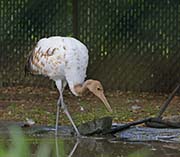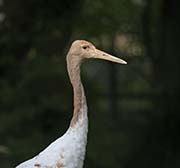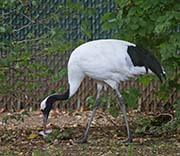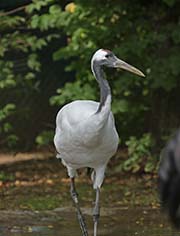Juvenile

Juvenile
10/09/2013 - Woodland Park Zoo, Seattle, WA
Juvenile
10/09/2013 - Woodland Park Zoo, Seattle, WA
|

Juvenile on the right
10/09/2013 - Woodland Park Zoo, Seattle, WA
Juvenile on the right
10/09/2013 - Woodland Park Zoo, Seattle, WA
|

Juvenile
10/10/2013 - Woodland Park Zoo, Seattle, WA
Juvenile
10/10/2013 - Woodland Park Zoo, Seattle, WA
|
Adult

11/19/2013 - Denver Zoo, Denver, CO
11/19/2013 - Denver Zoo, Denver, CO
|

04/15/2012 - Houston Zoo, Texas
04/15/2012 - Houston Zoo, Texas
|

04/15/2012 - Houston Zoo, Texas
04/15/2012 - Houston Zoo, Texas
|

10/09/2013 - Woodland Park Zoo, Seattle, WA
10/09/2013 - Woodland Park Zoo, Seattle, WA
|

10/10/2013 - Woodland Park Zoo, Seattle, WA
10/10/2013 - Woodland Park Zoo, Seattle, WA
|

04/18/2015 - Houston Zoo, Texas
04/18/2015 - Houston Zoo, Texas
|
Diet:
The Red-crowned Crane are omnivores.
They eat cultivated crops, aquatic plants, acorns, variety of fish,
frogs, salamanders, snails, crabs, dragonflies, ducklings,
small birds and small animals.
When they capture larger prey that they can't swallow whole,
they will shake the prey and eat the pieces as they are shaken off.
Most foraging occurs in wet grasslands, cultivated fields,
in shallow rivers or on lakeshores.
Courtship:
Red-crowned Cranes are monogamous and mate for life.
Red-crowned Cranes have an elaborate courtship dance in which they
will leap while calling, do head-bob to each other, and
bow with spread wings.
Grasses, sticks or feathers are tossed in the air.
Besides being part of the courtship ritual they are done throughout
the year which probably strengthens the pair bond.
Younger birds also 'dance' and the reasons for this may be to
help with motor development and to relieve aggression and tension.
Nesting:
Both sexes construct the nest on the ground in a marshy area.
It is made of reed and grasses.
The female lays 2 light brown spotted eggs.
The chicks are precocial and are born asynchronously and usually
only the eldest chick survives.
Both parents feed the chicks a protein-rich fish diet.
Habitat and Range:
Red-crowned Cranes are found in Japan, China, and the Korean Peninsula.
They are a highly aquatic species and feed in deeper water than other
cranes.
They breed in large wetlands in temperate East Asia and winter
along rivers and in coastal and freshwater marshes.
Vocalization:
Cranes have specialized vocal adaptations highlighted by
an extremely long trachea that coils within a hollow sternum.
They produce a wide variety of calls ranging from low pitched
purrs to the loud unison calls involved in
courtship and pair maintenance.
The calls of male and female cranes differ in pitch.
Plumage/Molt
Like most cranes, molts annually during the post-breeding season.
The main flight feathers are lost at the same time leaving the crane
flightless.
Migration:
The Red-crowned Cranes in Japan are not migratory.
The Cranes on the mainland breed in north-eastern China,
Russia and Mongolia (spring and summer)
and migrate to eastern China, North and South Korea (fall and winter).
Tongue/feet:
No further information.
Bibliography:
- Archibal, George W. and Meine, Curt, The Cranes: Status Survey and Conservation Action Plan,OICM. G;amd. Switzerland, 1996
- http://en.wikipedia.org The Free Encyclopedia, Accessed July, 2012
- www.savingcranes.org International Crane Foundation, Accessed July, 2012
- http://www.zoo.org Woodland Park Zoo, Seattle, WA, Accessed July, 2012
- http://nationalzoo.si.edu/Animals/Birds/Facts/FactSheets/fact-iiwi.cfm Smithsonian National Zoological Park, Accessed July, 2012
- http://arkive.org Arkive: Images of life on earth, Accessed July, 2012
Top of Page








